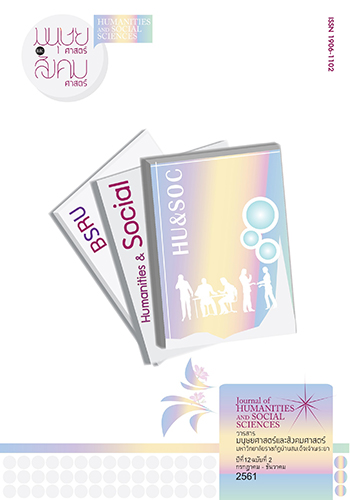การเรียนรู้ของผู้ป่วยผ่านกระบวนการเรื่องเล่าความเจ็บป่วย
คำสำคัญ:
เรื่องเล่า, การเล่าเรื่อง, ผลลัพธ์การเรียนรู้ของผู้ป่วยบทคัดย่อ
บทความนี้ มีวัตถุประสงค์เพื่อศึกษาการเรียนรู้ของผู้ป่วยโรคเรื้อรัง ที่เกิดปรากฏการณ์ของการเปลี่ยนแปลงภายในตน ซึ่งเกี่ยวข้องกับการสร้างจิตสำนึกใหม่และเกิดทักษะทางปัญญา ในการปรับตัวกับความเจ็บป่วยโดยใช้การเล่าเรื่องการเล่าเรื่องเป็นเครื่องมือที่มนุษย์ใช้เรียนรู้ความรู้สึกนึกคิดที่เป็นความละเอียดอ่อนของพฤติกรรมด้านใน เพราะสัญชาตญาณการเรียนรู้ของมนุษย์ จะตีความและเข้าใจความสัมพันธ์ของสรรพสิ่งได้ดีในรูปแบบของเรื่องราวซึ่งการเปลี่ยนแปลงภายในตนที่เกิดขึ้นวิเคราะห์ได้จากเนื้อหาของการเล่าเรื่องใน 5 ขั้นตอน ได้แก่ 1) ขั้นเรียนรู้เค้าโครงเรื่อง 2) ขั้นเชิญชวนให้ผู้ป่วยเล่าเรื่อง 3) ขั้นซึมซับเรื่องราว 4) ขั้นเข้าถึงความหมายของเรื่องราว และ 5) ขั้นปรับแก้เรื่องราวเป็นเรื่องเล่าฉบับสมบูรณ์ และนำผลของการเรียนรู้มาสรุปจัดหมวด แยกประเภท เป็นชุดความรู้ได้ 6 ประเด็น ประกอบด้วยการเข้าใจคุณค่าของชีวิต การสำนึกรู้การดูแลเอาใจใส่จากครอบครัว การเรียนรู้การกระทำของตนและผลกระทบกับผู้อื่น การเรียนรู้ในการเผชิญกับความเปลี่ยนแปลง การเรียนรู้หลักธรรมคำสอนเพื่อการเยียวยา 6) การสร้างอัตลักษณ์ใหม่ชุดความรู้นี้แสดงให้เห็นถึงคุณลักษณะของความเป็นมนุษย์ที่เจริญงอกงามขึ้นอย่างสอดคล้องสัมพันธ์กันทั้ง 3 ด้านคือ พฤติกรรม จิตใจและปัญญา คุณค่าและประโยชน์ของความรู้สามารถนำไปเพิ่มสาระในหลักสูตรการเรียนการสอนจิตบำบัดหรือกิจกรรมเสริมหลักสูตรการดูแลด้วยหัวใจความเป็นมนุษย์ให้กับนักศึกษาพยาบาล และจัดโครงการอบรม เพิ่มพูนความรู้ในรูปแบบของการจัดการความรู้หรือจัดกลุ่มแลกเปลี่ยนเรียนรู้ในชุมชน รวมถึงการใช้กระบวนการของเรื่องเล่าเป็นเครื่องมือสำหรับผู้ป่วยเพื่อการเยียวยาตนเอง
เอกสารอ้างอิง
กาญจนา แก้วเทพ. (2553). แนวพินิจใหม่ในสื่อสารการศึกษา. กรุงเทพฯ : ภาพพิมพ์.
กิติพัฒน์ นนทปัทมะดุลย์. (2552). ปรากฏการณ์วิทยา การกำหนดสร้างทางสังคมและศาสตร์แห่งการตีความในการปฏิบัติงานสังคมสงเคราะห์. เอกสารคำสอน วิชา สค.603 ทฤษฎีและการปฏิบัติงานสังคมสงเคราะห์ 1 ภาค 1/2552. หลักสูตรสังคมสงเคราะห์ศาสตร์มหาบัณฑิต มหาวิทยาลัยธรรมศาสตร์.
ธนา นิลชัยโกวิทย์ และ อดิศรจัทรสุข. (2552). ศิลปะการจัดกระบวนการเรียนรู้เพื่อการเปลี่ยนแปลง : คู่มือกระบวนกรจิตปัญญาศึกษา. นครปฐม : เอส.พี.เอ็น.การพิมพ์.
นภาภรณ์ หะวานนท์. (2552). วิธีการศึกษาเรื่องเล่า : จุดเปลี่ยนของการวิจัยด้านสังคมศาสตร์. ว.สังคม ลุ่มน้ำโขง. 5(2), 4-10.
มูลนิธิสดศรี สฤษดิ์วงศ์. (2550). แพทย์ศาสตร์ศึกษาองค์รวม. กรุงเทพฯ : แผนงานพัฒนาจิตเพื่อสุขภาพมูลนิธิสดศรี สฤษดิ์วงศ์.
ศิริวรรณ ลาภสมบูรณานนท์. (2557). เรื่องเล่าเพื่อการเยียวยา. โครงการวิจัยการสำรวจสถานภาพความรู้ สำนักวิจัยสังคมและสุขภาพ สำนักงานนโยบายและยุทธศาสตร์ สำนักงานปลัดกระทรวงสาธารณสุข.
Barbezat, P., & Bush, (2014). Contemplative Practices in Higher Education : Powerful Methods to Transform Teaching and Learning. (2nd ed.). San Francisco : Jossey-Bass.
Calssel, E.J. (2004). The Nature of Suffering and Goals of Medicine. (2nd ed.). New York : Oxford University Press.
Charon, R. (2006). Narrative Medicine: Honoring the Story of Illness. New York : Oxford University Press.
Mezirow, J. (2003). Transformative Learning as discourse. Journal of Transformative Education. (1), 58-63
ดาวน์โหลด
เผยแพร่แล้ว
รูปแบบการอ้างอิง
ฉบับ
ประเภทบทความ
สัญญาอนุญาต

อนุญาตภายใต้เงื่อนไข Creative Commons Attribution-NonCommercial-NoDerivatives 4.0 International License.




